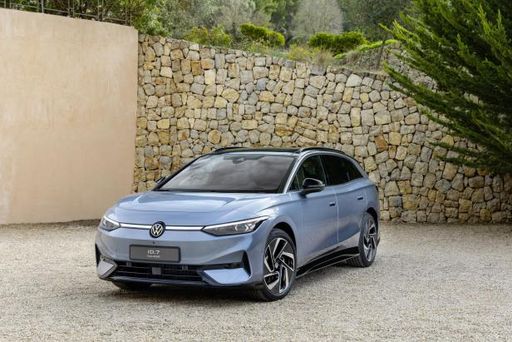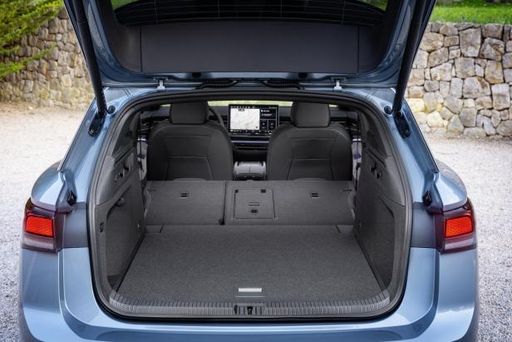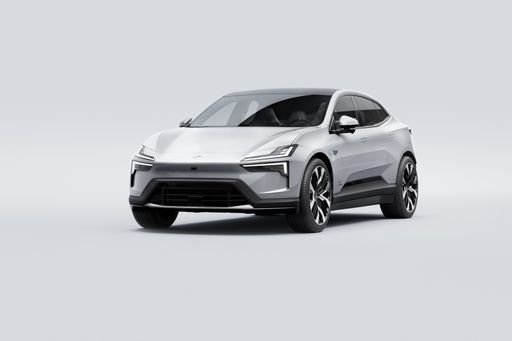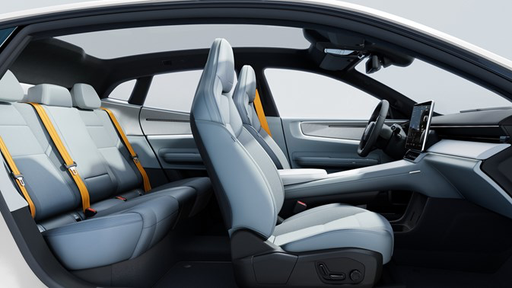VW ID.7 Touring vs Polestar 4 – Kumpi auto sopii sinulle paremmin?
Molemmilla malleilla on vahvuutensa – mutta kumpi sopii sinulle paremmin?
Vertaa suorituskykyä, kulutusta, hintaa ja tiloja suoraan: VW ID.7 Touring vai Polestar 4?
The automotive market continues to evolve rapidly, especially in the realm of electric vehicles (EVs). This article will delve into a detailed comparison between the VW ID.7 Touring and the Polestar 4. Both vehicles offer cutting-edge technology, impressive performance, and innovative designs aimed at enhancing the driving experience. Let’s explore how these two electric powerhouses stack up against each other.
Design and Body Style
The VW ID.7 Touring adopts a wagon body style that focuses on practicality and spaciousness. At 4,961 mm in length, it offers an impressive trunk capacity of 605 liters, making it an ideal option for families or long-distance travelers. The overall dimensions allow for a comfortable interior while maintaining a sleek profile.
On the other hand, the Polestar 4 is classified as an SUV, boasting a more robust and sporty look. Measuring 4,840 mm in length, it has a slightly smaller trunk capacity of 526 liters but compensates with a wider stance of 2,008 mm, which enhances driving stability and road presence.
Powertrain and Performance
The ID.7 Touring comes with two power outputs: a rear-wheel drive variant producing 286 HP and an all-wheel drive option that ups the ante to 340 HP. It features a notable torque rating of up to 679 Nm, allowing for a swift acceleration rate of 0-100 km/h in as little as 5.5 seconds. With battery capacities of 77 kWh and 86 kWh, it offers an impressive electric range of up to 690 km, making it one of the more long-range options in the EV segment.
Conversely, the Polestar 4 is designed for a more performance-oriented experience. Its range starts with a rear-wheel drive model producing 272 HP and can go up to 544 HP for the all-wheel drive variant, which allows for a blistering 0-100 km/h time of just 3.8 seconds. The Polestar’s larger 94 kWh battery delivers an electric range between 590 km and 620 km, though this still trails the ID.7 Touring’s greatest range in some configurations.
Efficiency and Consumption
Efficiency is crucial for EV consumers, and here both cars bring their strengths. The ID.7 Touring boasts a consumption rate of as low as 14 kWh per 100 km, underscoring its suitability for longer journeys without extensive charging needs. This is an excellent feature for drivers who prioritize range and efficiency.
The Polestar 4, however, registers a slightly higher consumption rate of 17.8 kWh to 18.7 kWh per 100 km. While it offers more horsepower and quicker acceleration, the trade-off is a bit more energy required for similar distances.
Interior and Technology
Inside, the ID.7 Touring is designed for comfort and technology, featuring a spacious cabin that hosts the latest infotainment system alongside premium materials. VW’s focus on user-friendly interfaces makes accessing navigation, music, and vehicle diagnostics a breeze. Its cabin prioritizes practicality, aiming to provide a superior family atmosphere.
The Polestar 4 also offers a modern interior layout with a tech-centric design. With Google built-in functionality, it provides a seamlessly integrated experience for handling navigation, music, and voice commands. The cabin aesthetics lean towards minimalism with high-quality materials, giving it a distinct Scandinavian flair.
Safety Features
Safety is paramount in modern EVs, and both models come equipped with a suite of advanced driver-assistance systems. The ID.7 Touring includes features such as adaptive cruise control, lane-keeping assist, and automatic emergency braking, reinforcing Volkswagen’s reputation for safety.
Similarly, the Polestar 4 features a robust array of safety technology, including advanced sensors and active safety features, solidifying its commitment to keeping drivers and passengers safe. Both vehicles are expected to perform well in safety ratings, further appealing to buyers who prioritize peace of mind on the road.
Conclusion
When comparing the VW ID.7 Touring with the Polestar 4, potential buyers are faced with two exceptional electric vehicles designed to cater to different preferences. The ID.7 Touring excels in range, efficiency, and spaciousness, making it great for family use and long road trips. Meanwhile, the Polestar 4 is poised to attract those seeking performance and stylish design.
Ultimately, the choice between the VW ID.7 Touring and the Polestar 4 will depend on individual needs—whether prioritizing range and practicality or performance and cutting-edge technology. As electric vehicles become more mainstream, both options represent the exciting future of automotive innovation.
Tässä mennään yksityiskohtiin: tekniset erot tarkemmin
Kustannukset ja kulutus: Hinta ja tehokkuus ovat usein ensimmäiset valintakriteerit auton ostossa. Tässä näkyy, kumpi malli on pitkällä aikavälillä edullisempi – tankatessa, ladatessa tai hankintahinnassa.
VW ID.7 Touring on hinnassa vähän edullisempi – sen lähtöhinta on 54900 €, kun taas Polestar 4 maksaa 61900 €. Ero on noin 6995 €.
Sähkönkulutuksessa etu on VW ID.7 Touring:lla. Se kuluttaa 14 kWh /100 km ja on erottuva energiatehokkaampi kuin Polestar 4, jonka kulutus on 17.80 kWh. Ero on noin 3.80 kWh.
Toimintamatkassa VW ID.7 Touring suoriutuu vähän paremmin: se yltää jopa 689 km:een, noin 69 km enemmän kuin Polestar 4.
Moottori ja suorituskyky: Teho, vääntömomentti ja kiihtyvyys ovat autoharrastajien klassisia mittareita – ja erot tulevat tässä hyvin esiin.
Moottoritehossa Polestar 4 on selvästi havaittava etulyöntiasemassa – 544 hv verrattuna 340 hv:een. Ero on noin 204 hv hv.
Kiihdytyksessä 0–100 km/h Polestar 4 on selvä nopeampi – 3.80 s vs. 5.50 s. Ero on noin 1.70 s sekuntia.
Huippunopeudessa Polestar 4 on vähäinen edellä – se yltää 200 km/h:een, kun taas VW ID.7 Touring saavuttaa 180 km/h. Ero on noin 20 km/h.
Vääntömomentissa näkyy myös ero: Polestar 4 vetää kevyt voimakkaammin, 686 Nm verrattuna 679 Nm:een. Eroa on noin 7 Nm.
Tila ja käytännöllisyys: Tehon ohella arjessa ratkaisevat mukavuus ja käytännöllisyys. Tässä selviää, kumpi auto on monipuolisempi ja tilavampi.
Molemmissa autoissa on tilaa 5 henkilölle.
Omapainossa VW ID.7 Touring on tuskin havaittava kevyempi – 2191 kg verrattuna 2230 kg:een. Painoero on noin 39 kg.
Tavaratilan koossa VW ID.7 Touring tarjoaa vähän enemmän – 605 L verrattuna 526 L:een. Ero on noin 79 L.
Maksimikantavuudessa VW ID.7 Touring pärjää vähän paremmin – jopa 1714 L, noin 178 L enemmän kuin Polestar 4.
Kantavuudessa VW ID.7 Touring on vähäinen parempi – 465 kg verrattuna 455 kg:een. Ero on noin 10 kg.
Kokonaisuudessaan Polestar 4 on voittaa vertailun selvästi ja nappaa näin DriveDuel Champion -tittelin.
Se vakuuttaa tasapainoisemmalla kokonaisuudellaan ja on käytännöllisempi kumppani arjessa.
VW ID.7 Touring
ID.7 Touring yhdistää moderneja muotoja ja tilavuutta, mikä tekee siitä erinomaisen valinnan perheille ja pitkän matkan kuljettajille. Korkealaatuiset sisätilat tarjoavat mukavuutta ja tyylikkyyttä, ja monikäyttöisyys takaa, että matkat sujuvat vaivattomasti. Tämä sähköauto ei ainoastaan tarjoa ympäristöystävällistä ajoa, vaan myös erinomaisia ajokokemuksia kaikissa sääolosuhteissa.
Tiedot @ Volkswagen
@ Volkswagen
 @ Volkswagen
@ Volkswagen
 @ Volkswagen
@ Volkswagen
Polestar 4
Uuden sukupolven Tesla Model 4 yhdistää tyylikkään muotoilun ja huipputeknologian. Sen sisätilat tarjoavat tilavaa ja modernia designia, joka tekee ajokokemuksesta entistä miellyttävämmän. Lisäksi Model 4:n innovatiiviset ominaisuudet tekevät siitä erinomaisen valinnan niin päivittäisiin matkoihin kuin pidemmillekin reissuille.
Tiedot @ media.polestar.com
@ media.polestar.com
 @ media.polestar.com
@ media.polestar.com
 @ media.polestar.com
@ media.polestar.com
 @ Volkswagen
@ Volkswagen
|

|
|
|
|
Kustannukset ja kulutus |
|
|---|---|
|
Hinta
54900 - 64100 €
|
Hinta
61900 - 69900 €
|
|
Kulutus L/100km
-
|
Kulutus L/100km
-
|
|
Kulutus kWh/100km
14 - 16.6 kWh
|
Kulutus kWh/100km
17.8 - 18.7 kWh
|
|
Sähköinen toimintasäde
584 - 689 km
|
Sähköinen toimintasäde
590 - 620 km
|
|
Akun kapasiteetti
77 - 86 kWh
|
Akun kapasiteetti
94 kWh
|
|
CO2
0 g/km
|
CO2
0 g/km
|
|
Polttoainesäiliön tilavuus
-
|
Polttoainesäiliön tilavuus
-
|
Mitat ja kori |
|
|---|---|
|
Kori
Farmari
|
Kori
SUV
|
|
Istuimet
5
|
Istuimet
5
|
|
Ovet
5
|
Ovet
5
|
|
Omamassa
2191 - 2336 kg
|
Omamassa
2230 - 2355 kg
|
|
Tavaratila
605 L
|
Tavaratila
526 L
|
|
Pituus
4961 mm
|
Pituus
4840 mm
|
|
Leveys
1862 mm
|
Leveys
2008 mm
|
|
Korkeus
1549 - 1551 mm
|
Korkeus
1534 mm
|
|
Maksimi tavaratila
1714 L
|
Maksimi tavaratila
1536 L
|
|
Kantavuus
459 - 465 kg
|
Kantavuus
455 kg
|
Moottori ja suorituskyky |
|
|---|---|
|
Moottorityyppi
Sähkö
|
Moottorityyppi
Sähkö
|
|
Vaihteisto
Automaatti
|
Vaihteisto
Automaatti
|
|
Vaihteiston tyyppi
Alennusvaihteisto
|
Vaihteiston tyyppi
Alennusvaihteisto
|
|
Vetotapa
Takaveto, Neliveto
|
Vetotapa
Neliveto, Takaveto
|
|
Teho hv
286 - 340 hv
|
Teho hv
272 - 544 hv
|
|
Kiihtyvyys 0-100 km/h
5.5 - 6.7 s
|
Kiihtyvyys 0-100 km/h
3.8 - 7.1 s
|
|
Huippunopeus
180 km/h
|
Huippunopeus
200 km/h
|
|
Vääntömomentti
545 - 679 Nm
|
Vääntömomentti
343 - 686 Nm
|
|
Sylinterien lukumäärä
-
|
Sylinterien lukumäärä
-
|
|
Teho kW
210 - 250 kW
|
Teho kW
200 - 400 kW
|
|
Iskutilavuus
-
|
Iskutilavuus
-
|
Yleiset |
|
|---|---|
|
Mallivuosi
2024
|
Mallivuosi
2024
|
|
CO2-tehokkuusluokka
A
|
CO2-tehokkuusluokka
A
|
|
Merkki
VW
|
Merkki
Polestar
|
Mitä vetotapavaihtoehtoja VW ID.7 Touring tarjoaa?
Mallia tarjotaan Takaveto tai Neliveto-versiona.
Näytetyt hinnat ja tiedot ovat arvioita, jotka perustuvat Saksan listahintoihin, ja voivat vaihdella maittain. Nämä tiedot eivät ole oikeudellisesti sitovia.
